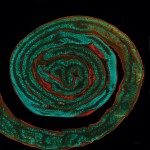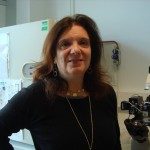Link to Pubmed [PMID] – 24960041
PLoS Biol. 2014 Jun;12(6):e1001890
During early development, modulations in the expression of Nodal, a TGFβ family member, determine the specification of embryonic and extra-embryonic cell identities. Nodal has been extensively studied in the mouse, but aspects of its early expression remain unaccounted for. We identified a conserved hotspot for the binding of pluripotency factors at the Nodal locus and called this sequence “highly bound element” (HBE). Luciferase-based assays, the analysis of fluorescent HBE reporter transgenes, and a conditional mutation of HBE allowed us to establish that HBE behaves as an enhancer, is activated ahead of other Nodal enhancers in the epiblast, and is essential to Nodal expression in embryonic stem cells (ESCs) and in the mouse embryo. We also showed that HBE enhancer activity is critically dependent on its interaction with the pluripotency factor Oct4 and on Activin/Nodal signaling. Use of an in vitro model of epiblast maturation, relying on the differentiation of ESCs into epiblast stem cells (EpiSCs), revealed that this process entails a shift in the regulation of Nodal expression from an HBE-driven phase to an ASE-driven phase, ASE being another autoregulatory Nodal enhancer. Deletion of HBE in ESCs or in EpiSCs allowed us to show that HBE, although not necessary for Nodal expression in EpiSCs, is required in differentiating ESCs to activate the differentiation-promoting ASE and therefore controls this regulatory shift. Our findings clarify how early Nodal expression is regulated and suggest how this regulation can promote the specification of extra-embryonic precusors without inducing premature differentiation of epiblast cells. More generally, they open new perspectives on how pluripotency factors achieve their function.

